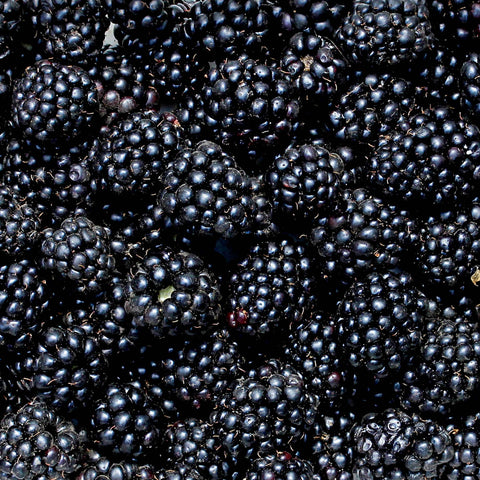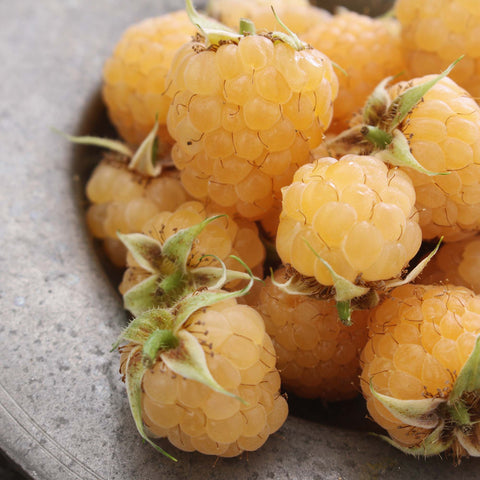How to Grow Blackberry Bushes
Fresh blackberries are the highlight of summer. Juicy, tart, and perfect baked in a pie, they are a must for a home garden. They aren’t difficult to grow, and the reward of fresh berries every year is priceless. You don’t even need an ample garden space; there are varieties on the market today that grow readily in pots on your deck. Having fresh blackberries has never been easier! Learn how to grow blackberry bushes today.
Best Selling Berry Bushes



Blackberry Facts
Blackberries or sometimes called black raspberries grow from fruiting canes, not bushes or trees. These canes sprout from a central spot called the crown. The canes look like long, thin brown sticks with thorns, all shooting up from the same place. Blackberry crowns are perennial and will live for upwards of 15-20 years. The canes, though, only live two years. And, the first year, they do not produce fruit. This means that sprouting from a central crown will be many canes, some that are in their first year and not producing fruit and others in their second year, producing fruit. New canes grow every year and continue the process for decades. Big Beautiful Blackberries
Big Beautiful Blackberries In their first year, canes grow to their full length, between 9-20 feet, or less for a dwarf variety. Canes that are not trained on a trellis or frame quickly become entangled as they bend and weave between each other, creating a bramble or dense thicket.
Blackberry Varieties
There are hundreds of blackberry cultivars, and choosing the right one is essential. These are the most important features to consider.- Hardiness: Climate suitability is the most important feature. If you live in a cold climate, choose one that can withstand winter temperatures. In warmer areas, you’ll need a variety that succeeds in a mild climate. Check with a local nursery for the best-recommended cultivars for your region.
- Size: Standard cultivars easily grow between 10-19 feet and need a trellis or frame, so they don’t get out of control. Compact varieties average between 3-5 feet, making them perfect for container growing or small gardens.
- Growth Habit: There are two main growing types – trailing and erect. Trailing blackberries grow extensive canes that quickly become tangled without supports. They need regular pruning to keep them under control. Erect varieties produce straight, rigid canes. They also are best managed with some trellising, but in general, they are easier to contain. Many people report a huge taste difference between the two, with trailing blackberries having the better classic, blackberry flavor.
- Thorns or Not: The majority of cultivars have thorns. Thornless blackberries are relatively new to the market. While it is wonderful not to deal with thorns, for now, choosing a type without thorns greatly limits your options.
Prime Ark Freedom Blackberry Bush: thornless, yields fruit early in the season and has large, tasty fruit.
Ouachita Blackberry Vine: thornless, with upright and erect cane stalk.
Navaho Blackberry Bush: thornless, produces small to medium- sized berries.
Arapaho Blackberry Bush: thornless, produces large black and red berries that are early ripening.
Kiowa Blackberry Bush: produces large fruit and has a 6ft stalk.
How to Plant Blackberries
Blackberries should be planted in spring after all danger of frost is gone. Choose a location that gets full sun. Blackberries require a fertile, slightly acidic soil, drained soil, with a pH between 5.6-6.2. If you’re unsure about your soil, get it tested. Make any needed adjustments to the soil before planting such as adding soil amendments.Set up a trellis or support system before you plant the canes. The canes are thin and flexible; once they are covered in fruit, they can no longer support themselves and will bend over with the weight.
Blackberries starts are sold in containers or as bare root plants. Either is fine for planting in a home garden or raised bed. If the bare roots look gnarled and knobby, don’t be alarmed.
 Planting a Blackberry Bush Plant the new crowns 2-3 feet apart, if they are erect or semi erect blackberry varieties. Trailing types need to be 5-8 feet apart. Place them in holes that put the top of the crown right at ground level or slightly below. Do not bury them deeply. Once they are planted, arrange mulch or compost around the base to protect them from inclement weather and suffocating weeds, and to preserve moisture. Now your plants will produce berries for you year after year.
Planting a Blackberry Bush Plant the new crowns 2-3 feet apart, if they are erect or semi erect blackberry varieties. Trailing types need to be 5-8 feet apart. Place them in holes that put the top of the crown right at ground level or slightly below. Do not bury them deeply. Once they are planted, arrange mulch or compost around the base to protect them from inclement weather and suffocating weeds, and to preserve moisture. Now your plants will produce berries for you year after year.
Blackberry Bush Care
During the growing season, blackberries need between 1-2 inches of water per week. If the natural rainfall doesn’t meet this need, you’ll have to water them. In early spring, apply a balanced fertilizer and then a second application around six weeks later. The N-P-K values on the fertilizer should be the same, for example, 10-10-10.Every year, prune away the old canes. Remember, they only produce the second year; then they need to be cut away to make way for new growth. This is best done in late winter. Old canes will be gray with peeling bark, so they are easy to separate from the rest.
Growing Blackberries in Containers
Choose a dwarf variety, specially bred for container growing. Many of these are also thornless, which makes them much safer to have on the deck or patio, especially if there are kids around. Don’t worry, though, the fruits are still full-size and delicious! Each crown will need an 8-12 gallon container. Do not try to force them into a smaller one. The container must have holes for proper drainage, or the roots will rot. Use a good potting mix combined 50/50 with compost.Water blackberries when the top layer of soil feels dry. Don’t neglect this! And, add fertilizer every spring to give the canes necessary nutrients for growth. Pruning is the same as with garden-grown types.
For more information on how to care for your blackberry plant please follow the link: https://www.arborday.org/trees/fruit/care-blackberry.cfm
We hope this article was informative and inspires you to get outside and learn how to grow blackberry bushes. They are one of the easiest fruiting plants to grow and take little to no effort to harvest fruit. Enjoy your delicious and nutritious blackberries for many years to come. Don’t forget we have several varieties for sale on our website. Let us ship your next home garden project directly to your home. Reach out to us with any questions you may have.


























